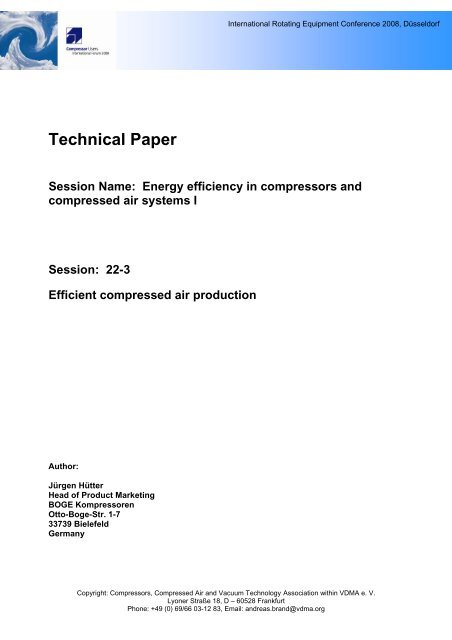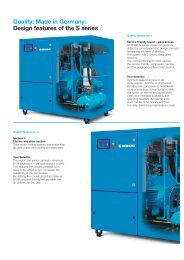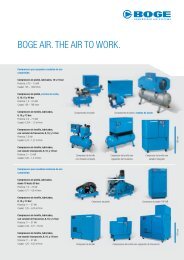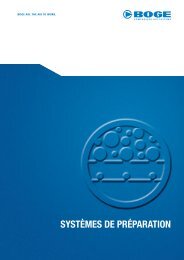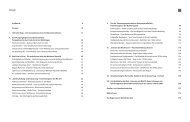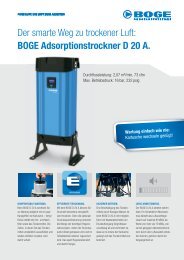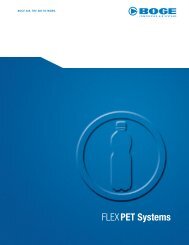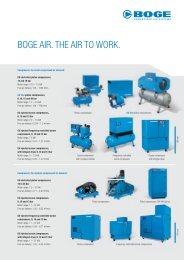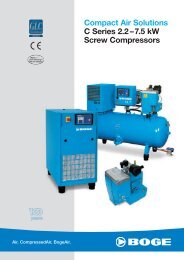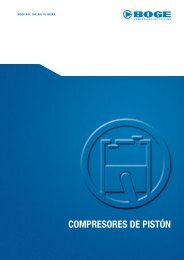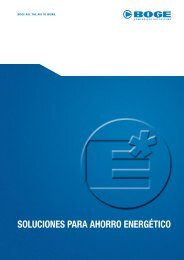Technical Paper Session Name: Energy ... - Boge Kompressoren
Technical Paper Session Name: Energy ... - Boge Kompressoren
Technical Paper Session Name: Energy ... - Boge Kompressoren
Create successful ePaper yourself
Turn your PDF publications into a flip-book with our unique Google optimized e-Paper software.
<strong>Technical</strong> <strong>Paper</strong><br />
International Rotating Equipment Conference 2008, Düsseldorf<br />
<strong>Session</strong> <strong>Name</strong>: <strong>Energy</strong> efficiency in compressors and<br />
compressed air systems I<br />
<strong>Session</strong>: 22-3<br />
Efficient compressed air production<br />
Author:<br />
Jürgen Hütter<br />
Head of Product Marketing<br />
BOGE <strong>Kompressoren</strong><br />
Otto-<strong>Boge</strong>-Str. 1-7<br />
33739 Bielefeld<br />
Germany<br />
Copyright: Compressors, Compressed Air and Vacuum Technology Association within VDMA e. V.<br />
Lyoner Straße 18, D – 60528 Frankfurt<br />
Phone: +49 (0) 69/66 03-12 83, Email: andreas.brand@vdma.org
Abstract<br />
International Rotating Equipment Conference 2008, Düsseldorf<br />
Compressed air is often referred to as the fourth utility. We all know the generation of<br />
compressed air consumes energy but at the same time the compressor and downstream<br />
components are often neglected, which means there are significant savings to be made.<br />
It is suggested that savings of around 33 % on average in a compressed air system are<br />
possible. It follows that cost effective compressed air production is energy efficient<br />
compressed air production, as energy is by far the biggest lifetime cost factor.<br />
Many of the different levers for cost reduction may be known, but just not applied, due to<br />
lack of knowledge about the financial savings possible. This paper shows and explains<br />
the different ways to efficient compressed air production (leakages, compressor<br />
selection, pressure losses, …) and gives simple calculation examples that are easy to<br />
follow and to be reproduced in your compressed air stations.
Efficient compressed air production<br />
International Rotating Equipment Conference 2008, Düsseldorf<br />
Compressed air is one of the most important utilities used in industrial applications world wide; if<br />
not the most important. There is hardly any industrial facility working without compressed air.<br />
Two reasons are its unique flexibility and easy handling. Many processes depend on<br />
compressed air, therefore compressed air will definitely remain an important driver for<br />
production in the future.<br />
Compressed air has been in use for many years. The first known application is almost as old as<br />
our Christian time scale. Over the years industry became used to the presence of compressed<br />
air. It is just there, a utility, very much comparable to electricity in a private household. But just<br />
like electricity compressed air does have its costs. Due to ever increasing energy prices the cost<br />
for generating compressed air has moved more and more into the focus of the managers<br />
responsible for generating it. In former years the situation was different. Compressed air<br />
stations or compressed air production was more or less a neglected part of any facility. <strong>Energy</strong><br />
efficiency was not in focus and any possible saving potential was never contemplated. This<br />
resulted in a rather bad reputation of compressed air today. Many compressor stations actually<br />
do not work efficiently. However this is not a general problem of compressed air itself but only a<br />
problem of ignoring the high energy saving potential that is undoubtedly available. Compressed<br />
air is definitely a viable and safe utility. The skill is knowing and practising the methodology to<br />
reduce the generation and distribution costs to a minimum.<br />
Costs of compressed air<br />
When buying a new compressed air station, especially with the smaller motors, say 22 kW and<br />
below, the usual situation is that supplier and purchaser only talk about investment costs or<br />
maintenance costs. <strong>Energy</strong> costs are rarely discussed. Therefore a vital part of the equation is<br />
missed. Three cost factors are most important: <strong>Energy</strong> costs, investment costs and<br />
maintenance costs. Depending on the annual working hours of the compressor the proportion of<br />
these three factors is slightly different.<br />
Total costs<br />
100%<br />
90%<br />
80%<br />
70%<br />
60%<br />
50%<br />
40%<br />
30%<br />
20%<br />
10%<br />
0%<br />
2000 op.h/a 4000 op.h/a 7500 op.h/a<br />
Fig. 1: Cost factors for compressed air production [1]<br />
Maintenance costs<br />
<strong>Energy</strong> costs<br />
Investment costs
International Rotating Equipment Conference 2008, Düsseldorf<br />
Fig. 1 clearly shows that energy is the biggest factor in the cost of compressed air, no matter<br />
how many hours per year the compressor is in use. The significance of energy costs rise even<br />
more with increased operating hours. The investment costs only form a small percentage of the<br />
total costs and clearly do not represent the amount of time spent in all those negotiations during<br />
the buying process. Also the maintenance costs are less important, compared to the total costs.<br />
As the energy costs have the biggest share it should be very clear that this is the area that<br />
should be tackled when talking about reducing costs. Reducing costs basically means reducing<br />
energy consumption.<br />
In 2001 a study was published by Peter Radgen and Edgar Blaustein called “Compressed Air<br />
Systems in the European Union”. This study analysed the situation of compressed air stations in<br />
the European Union and found out that, in that time in the European Union, about 321,000<br />
industrial compressed air systems (CAS) were in use, consuming about 80 billion kWh of<br />
energy per year. The study also analysed the possible energy saving potential for these<br />
compressor stations. (Fig. 2)<br />
Fig. 2: Potential contribution to energy saving measures [2]<br />
The table suggested an energy saving potential of 32.9 %. Taking the total 80 billion kWh used<br />
per year this would result in 26.3 billion kWh per year of saved energy. With an average energy<br />
price of 0.06 €/kWh the saving potential results in 1.58 billion Euro saved per year.<br />
The table also shows the most important contributors to this saving potential. Obviously leakage<br />
reduction is the most important one, followed by overall system design, heat recovery, intelligent<br />
drives and intelligent controls. These are some of the measures that will be discussed in this<br />
paper.
International Rotating Equipment Conference 2008, Düsseldorf<br />
The mentioned 32.9 % is a value which is, on average, applicable to all stations in the European<br />
Union. No matter what size the station is. But why is this big saving potential not used,<br />
especially in times like this, where energy costs are rising faster than ever before?<br />
One possible explanation is that in many industrial facilities compressed air costs are not<br />
evaluated in a transparent way. It is often very hard to find out the costs specifically used for the<br />
compressed air production, because the necessary data is not collected. If one does not know<br />
the total costs it is hard to figure the saving potential. Because the importance of the energy<br />
costs is not clear to all compressed air users this small calculation will highlight the significance:<br />
Calculation of cost factors<br />
The compressed air station in this example consists of a single, fixed speed 45 kW oil injected<br />
screw compressor operating 6,000 hours per year, with an idling time ratio of 33 %. Thus the<br />
compressor runs 4,000 h/a in load run and 2,000 h/a in idle run. This ratio is not very efficient,<br />
but it is quite common to installations of this kind.<br />
In this example we will calculate the three cost factors: a) energy, b) investment and c)<br />
maintenance costs.<br />
a) Calculation of energy costs<br />
The rated motor power of this compressor is 45 kW. This is the power available at the motor<br />
shaft. The power intake of the compressor, the value which has to be paid for, also includes the<br />
motor efficiency (estimated with 93 %) and the rated power including efficiency of the cooling<br />
fan motor (estimated with 0.7 kW and 70 %), which is also installed in compressors of this size.<br />
The power intake therefore results to: 45 kW / 93 % + 0.7 kW / 70 % = 49.4 kW. This is what the<br />
compressor uses during load run. During idle run the compressor usually uses about one third<br />
of this energy. This is the basis for our following energy calculation. The energy costs are<br />
estimated with 0.06 €/kWh.<br />
Costs for load run: 4,000 h/a x 49.4 kW x 0.06 €/kWh = 11,856 €/a<br />
Costs for idle run: 2,000 h/a x 49.4 kW / 3 x 0.06 €/kWh = 1,976 €/a<br />
Total energy costs: 13,832 €/a.<br />
b) Calculation of investment costs<br />
The purchase price of this example compressor is estimated at 14,000 €. With a linear<br />
depreciation over 7 years and 8 % interest rate the yearly costs for investment are roughly<br />
calculated with 14,000 € / 7 a x 1.08 = 2,160 €/a.<br />
c) Calculation of maintenance costs<br />
The compressor runs 6,000 hours per year. The total maintenance costs for an installation like<br />
this are roughly estimated with 1,200 €/a.<br />
Total costs<br />
Adding all three cost factors gives total annual costs for this compressor of 17,192 €. The<br />
13,832 €/a energy cost equates to 80 % of the total. Investment costs are only 13 % and<br />
maintenance costs only 7 % of the overall figure.<br />
The costs per m³ can now also easily be calculated. With a volume flow of 7 m³/min at 8 bar the<br />
compressor delivers 7 m³/min x 60 min/h x 4000 h/a = 1,680,000 m³/a. This results in cost per
International Rotating Equipment Conference 2008, Düsseldorf<br />
m³ of 1 Cent/m³. This of course only includes the costs for the compressor, leaving out the costs<br />
for all other components of the compressor station.<br />
This calculation example clearly shows that the real money saving potential does not lie in<br />
buying a cheap compressor but in buying an energy efficient compressor. In this example the<br />
result of even only 2 % improved energy efficiency exceeds the saving potential of a 10 %<br />
reduction in purchasing price. Unfortunately the total Life Cycle Costs (LCC) are not always<br />
used as the relevant basis for purchasing decisions.<br />
Choosing energy efficient compressors is something that should be done every time a new<br />
compressed air station is designed or when a compressor is exchanged. But there are also<br />
other measures for existing compressor stations that can reduce energy costs.<br />
Effect of leakages<br />
The study by Radgen/Blaustein shows an average saving potential of 16 % for leakage<br />
reduction. The operator of any compressor station should therefore keep a careful eye on<br />
leakages in his compressed air system. The following figure illustrates the cost of leakages.<br />
Leakage Leakage Losses<br />
size volume at 8 bar ü <strong>Energy</strong> Money<br />
[ mm ] Size [ l/min ] [kW] [ €/J ]<br />
1 75 0,6 315,-<br />
1,5 150 1,3 683,-<br />
2 260 2,0 1051,-<br />
3 600 4,4 2312,-<br />
4 1100 8,8 4625,-<br />
5 1700 13,2 6938,-<br />
Fig. 3: Costs of leakages [1]<br />
Every compressed air system has leakages. Some installations have an excellent leakage rate<br />
of only 5 %, others have leakage rates of 50 % or even higher. The leakages seldom occur in<br />
the main piping, but in flanges, connections, couplings, maintenance units or in the compressed<br />
air tool itself.<br />
In our example the overall average leakage saving potential of 16 % results in an energy saving<br />
potential of 13,832 €/a x 16 % = 2,213 €/a.<br />
Additionally, reducing leakage volume also results in reduced operating hours of the<br />
compressor: 6,000 h/a x 16 % = 960 h/a. This will reduce the maintenance costs. (6,000 h/a is<br />
used because reducing the load run time will also affect the total idle run time.)<br />
Finding air leakages is not a problem, if the right tools are used, for<br />
example an ultra sonic sensor that detects emissions from a<br />
leakage (see Fig.4). This sensor should be used at least twice a<br />
year to audit a system and leakages should then immediately be<br />
repaired. To purchase an ultra sonic leak detector is a small<br />
investment, thereafter the only additional overhead is your labour<br />
cost. The annual saving potential definitely outweighs the<br />
Money values for:<br />
Electricity costs 0.06 €/kWh<br />
Leakage time 8,760 h/a<br />
Fig. 4: Leakage detector [3]
International Rotating Equipment Conference 2008, Düsseldorf<br />
investment and manpower cost. As this device only detects ultra sonic sound emissions it can<br />
be used during normal operation of<br />
the plant.<br />
There also is one way to find out the absolute leakage volume flow. During complete standstill<br />
of all compressed air users there still is air consumption because of the leakages. When the<br />
receiver is brought to a certain pressure value the compressors are switched of and the time for<br />
the pressure reduction in the receiver is measured. A pressure reduction from 8 bar to 6 bar in a<br />
1,000 l receiver over 2 minutes equals to a leakage volume flow of 1,000 l x (8-6) / 2 min =<br />
1,000 l/min. The costs for this leakage rate would be approx. 4,500 €/a. (see Fig. 3)<br />
Another method to measure the leakage rate is of course a complete measurement of the<br />
compressed air volume flow. The measured flow during times of standstill of all air consumers,<br />
for example during night or weekend, must then be leakages.<br />
One of the easiest ways to prevent leakage costs, at least during non shift times, is to shut<br />
down the compressors during this time, or, to prevent changing pressures in the receiver, to<br />
close a valve after the receiver.<br />
Operating pressure<br />
Another very important factor affecting the energy consumption of a compressed air system is<br />
the working pressure required. The pressure generated should always be at the minimum<br />
possible level to save energy. One important fact is: every 1 bar of additional pressure requires<br />
approx. 6-10 % more energy. This means, reducing the pressure by 1 bar immediately reduces<br />
the energy costs by 6-10 %. Therefore it is very important to reduce all pressure losses in the<br />
compressed air system from the receiver to the air consumer.<br />
6 bar<br />
dryer<br />
piping<br />
spiral connection<br />
2 filters<br />
pressure reducer<br />
12.3 bar 11.3 bar dp 0.3bar dp 1.5 bar dp 1.5 bar dp 1.5 bar dp 0.5 bar 6 bar<br />
Fig. 5: Example of a compressor station with unnecessary pressure losses<br />
Fig. 5 shows a compressor installation with many unnecessary pressure losses that cost<br />
money. Although only 6 bar is needed at the point of use the receiver pressure has to be 11.3<br />
bar and the compressor has to run with a maximum pressure of 12.3 bar, due to the necessary<br />
pressure hysteresis in the compressor cut-in and cut-out pressure settings. Connections with<br />
spiral hoses create a high pressure loss, pressure reducers should be avoided wherever<br />
possible, the piping diameter should be big enough to reduce pressure losses and filter<br />
elements should be replaced as early as possible. The pressure drop in this installation could<br />
certainly easily be reduced by 2 bar, reducing the energy consumption by approx. 15 %. Taking<br />
the 13,832 €/a energy costs of our example compressor this equals to 2,075 €/a. In most cases<br />
this saving potential can be used with almost no additional investment. Small things like early
International Rotating Equipment Conference 2008, Düsseldorf<br />
filter element change already save money. Reducing the pressure loss in these to filters to the<br />
half will alone save more than 800 €/a. This is much more than the cost of two new filter<br />
elements.<br />
The diameter of the piping is also very important for the energy costs. In many installations the<br />
piping diameter is much too small. Calculating the energy costs caused by the piping pressure<br />
loss and comparing them to the costs of an additional piping will in most cases show a return on<br />
investment of less than one year.<br />
Of course the pressure can only be lowered to such a level that all consumers still work<br />
efficiently. But if only a small percentage of compressed air is needed at an exceptional high<br />
pressure level it makes sense to use a booster compressor which can be fed from a standard<br />
low pressure net, produced at lower energy costs.<br />
Intelligent plant layout<br />
Generating different pressures from the main system is already one factor in an intelligent plant<br />
layout. But there are many more. The most important basis for a decision of what compressor<br />
plant layout to choose is the knowledge of the compressed air requirements. This does not only<br />
include an average volume flow but also information about maximum and minimum flow, the<br />
fluctuation in flow, required pressure, necessary compressed air quality and much more.<br />
Only when this information is known can a system layout be optimised to keep the energy costs<br />
at a minimum level. This especially includes the idling times of the installed compressors.<br />
For screw compressors with an intelligent compressor controller it is quite easy to analyse the<br />
idling time. The controller will give information about load run hours and idle run hours or total<br />
hours. The idling ratio can be calculated by dividing the idle hours by the total hours. This ratio<br />
should be as small as possible. Simple and cheap compressor controllers that only show the<br />
total hours on an analogue mechanical hour counter do not offer this information. These<br />
compressors usually also do not include intelligent systems to minimise idling time.<br />
Unfortunately in most cases the information about the required volume flow is not available. A<br />
layout therefore will always include uncertainties and also some unwanted idling times.<br />
In cases where an existing plant is to be modified or extended a measurement of the<br />
compressor station is highly advisable. These measurements should be done over one<br />
complete week to receive information about every working day, night time and also the<br />
weekends.<br />
Fig. 6: Measurement result [4]<br />
The diagram in Fig. 6 shows the working characteristic<br />
of a compressor station on a certain day, including the<br />
working mode of all compressors, pressure, volume<br />
flow and, in this case, also speed of a frequency<br />
controlled compressor. All this can be measured with a<br />
device that is easily installed into any compressor<br />
station. An analysis like this gives valuable information<br />
about the compressor station performance and<br />
efficiency.
International Rotating Equipment Conference 2008, Düsseldorf<br />
A measurement like this is the ideal basis for evaluating a system design requirement. It can<br />
determine whether to choose a single compressor, several compressors at different sizes or<br />
maybe a frequency controlled compressor.<br />
Looking at our example plant from the beginning maybe a prior measurement would have<br />
shown that a combination of two differently sized compressors (probably 30 kW and 15 kW)<br />
would be more efficient. This combination would use the bigger compressor as the base load<br />
compressor and the smaller one for peak loads. This would help reduce the idling costs of<br />
almost 2,000 €/a by half.<br />
For compressor stations with several compressors it is very important to have an intelligent<br />
higher level control that decides what compressor combination should run at a certain required<br />
air flow, minimising the total idling time and costs. There are small base load switch over<br />
controls for small installations and powerful energy saving controls for stations with 16<br />
connected compressors or more. In stations with more than 2 compressors a higher level<br />
control should be used. Using this, instead of the formerly used cascaded settings for multiple<br />
compressor installations definitely saves energy and money. Only the most efficient compressor<br />
combination will run, thus minimising idling time whilst at the same time optimising the pressure.<br />
In all discussions about the efficiency of a compressed air station and plant layouts it is always<br />
important to see the compressed air production as a complete system. An efficient compressor<br />
does not automatically make an efficient compressed air system. One mistake in the plant<br />
layout can destroy the complete plant efficiency. It is therefore very important to include all<br />
components from the very beginning in order to create an optimised system.<br />
Heat recovery<br />
9% Heating of<br />
motor<br />
72%<br />
Oil cooler<br />
100%of<br />
generated heat<br />
4%<br />
Heat in<br />
compressed air<br />
13%<br />
Aftercooler<br />
2%<br />
Heat radiation<br />
Fig. 7: Compression heat in a screw compressor [1]<br />
During the compression process a high<br />
percentage of the consumed energy is<br />
transferred into heat. In an efficient compressor<br />
installation this heat is not lost, but used to save<br />
energy in other applications where heat is<br />
needed. About 70 % to 80 % of the energy used<br />
to run a compressor can be recovered and<br />
therefore saved in other places.<br />
There are two main ways for heat recovery on<br />
screw compressors:<br />
- use the warm cooling air flow coming<br />
from the compressor<br />
- use the heat from the compressor oil<br />
circuit<br />
Fig. 7 shows the different streams of heat out of an air cooled oil injected screw compressor.<br />
The heat from the drive motor, the oil cooler and the air aftercooler leaves the compressor in<br />
one stream of warm air, taking out 94 % of the generated heat. This cooling air flow can be
International Rotating Equipment Conference 2008, Düsseldorf<br />
used to heat rooms or production facilities. All that is needed is an air duct connected to the<br />
compressor cooling air outlet. Fig. 8 shows an example installation. This is the simplest method<br />
of heat recovery, immediately saving energy which otherwise would have to be used to heat the<br />
building.<br />
Cooling air flow<br />
iwinter<br />
Cooling air<br />
Fig. 8: Example installation of heat recovery from cooling air [1]<br />
Another possible way for heat recovery is to take the heat from the oil circuit in the compressor<br />
with a heat exchanger. The advantage is that heat is then taken from the place where it is<br />
generated and from the hottest medium. Hot water with a temperature of up to 70°C can be<br />
generated which can be used in other places. This way of heat recovery is independent from<br />
the type of compressor cooling. One possible application would again be to supplement a<br />
central heating system whereby a significant amount of oil or gas for the heater can be saved.<br />
Drive Discharged Usable Saving<br />
rate power heat potential<br />
amount at 1,000 op.h<br />
[kW] [kW/h] [MJ/h] [€]<br />
22 17,7 63,7 1,118<br />
30 24,4 87,8 1,540<br />
37 30,3 109,0 1,912<br />
45 37,7 135,7 2,381<br />
55 45,5 163,8 2,874<br />
65 54,9 197,6 3,467<br />
75 63,1 227,1 3,984<br />
90 74,0 266,4 4,674<br />
110 90,0 324,0 5,684<br />
132 110,5 397,0 6,965<br />
160 133,5 480,6 8,432<br />
200 168,3 605,8 10,628<br />
250 208,9 752,0 13,193<br />
Cooling air flow<br />
isummer<br />
Fig. 9 shows a table with possible saving<br />
potential when heat recovery is used. The saving<br />
potential is calculated for a single shift operation<br />
(2,000 op. h) and heat recovery only done during<br />
half of the year (1,000 op. h). In an application<br />
where the recovered heat is used in a three shift<br />
operation throughout the year, the saving<br />
potential is even six times bigger. In most cases<br />
the return on investment for heat recovery<br />
installations is very short. When building a new<br />
compressor station heat recovery should always<br />
be considered. That would also include choosing<br />
the compressor location as near as possible to a<br />
heat consumer.<br />
Fig. 9: Saving potential for heat recovery (calculated at a<br />
price of only 0.50 €/l for heating oil)
Conclusion<br />
International Rotating Equipment Conference 2008, Düsseldorf<br />
Compressed air can be produced in an energy efficient and cost efficient manner. Unfortunately<br />
savings potential is seldom recognised by air consumers. In total an average saving potential<br />
around 33 % is possible. If this total saving potential was realised in the illustrated compressor<br />
installation a total saving of 13,832 €/a x 32.9 % = 4,550 €/a can be achieved. Many of the key<br />
measures have been discussed in this paper. When planning a new compressor station or<br />
renewing an existing one all the above mentioned points should be taken into consideration.<br />
Compressed air can then be used in any facility at highest flexibility and best price/performanceratio.<br />
Bibliographic details<br />
[1] BOGE Compressed Air Compendium, BOGE <strong>Kompressoren</strong><br />
[2] Radgen/Blaustein, Compressed Air Systems in the European Union, 2001<br />
[3] Picture: BOGE<br />
[4] Extract from BOGE AIReport analysis


